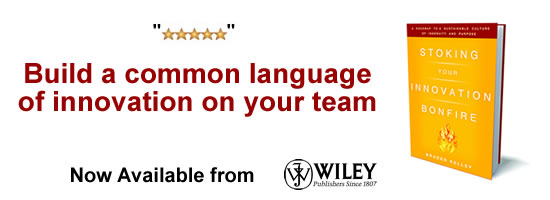Seven Trends Driving The Future of Innovation

Kraft Heinz’ stock is down 50 percent over the past 12 months, turnover in the executive ranks has increased, and the company’s inability to keep pace with changing consumer tastes is largely to blame. In an earnings call with investors, Kraft   Heinz CEO Miguel Patricio observed that “we’ve been too focused on the present, and literally on firefighting. We need to focus on our competencies for the future.â€
Yet a newly-released survey of over 200 major companies reveals Kraft Heinz is not alone. While most firms believe they’re “picking up on signals of change†that might disrupt their lines of business, fewer than half (42 percent) admit that they’re unable to act on those signals.
This is but one finding from “Benchmarking Innovation Impact†report, produced by Innovation Leader, an information and research firm in Boston, and sponsored by KPMG LLP. The report is an insightful collection of quantitative data about how big companies staff, structure, and fund their innovation efforts and includes interviews with companies like Google, Cisco, Bose, ESPN, and Capital One.
This year’s report surveyed 215 innovation, strategy, and R&D executives at large companies. To understand how the more sophisticated companies in that cohort were different from the average respondent, Innovation Leader identified a set of “role model†respondents that represented about 12 percent of the complete respondent set. These were respondents who’ve had innovation programs and processes in place for several years, and are starting to produce consistent and concrete outcomes.
Here are seven of the most surprising and counter-intuitive findings from this year’s report:
1. Seeing isn’t the same as doing.
Most companies see and talk regularly about the changes affecting their industry — like fast-moving competitors or changing customer behaviors. But they lack the ability to connect those observations to fast action. Call it the “seeing-doing gap.â€
2. Rewarding innovation and innovators will always be a challenge.
Said another way, trophies are OK; time and money are better. The most commonly-used incentive to get employees participating in innovation programs is some sort of award or recognition. (“You get an Apple Watch! And you get an Apple Watch!â€) But among the role model set of companies, surveyors found a higher percentage of companies supplementing recognition with dedicated time to continue developing an idea (30 percent) or seed funding (22 percent.) Google’s “20 percent time†for pet projects may be a bit of a myth, but some companies are trying to help employees get the time and funding they need to keep moving their projects forward.
3. Revenue generation is the mother of all metrics.
Among the “role model†set, revenue generated by new products or services was being measured by fully two-thirds of respondents. And 41 percent said they were also tracking cost reductions or efficiencies. It’s not enough just to collect metrics, though — they need to be communicated and disseminated to relevant colleagues up and down the org chart.
4. Recession worries haven’t yet rattled corporate innovators.
Despite stock market tremors, trade disputes, and slowing growth in many parts of the world, more than half (56 percent) of the corporate innovators in the Innovation Leader survey expect their company’s overall investment in innovation to increase from 2019 to 2020; just 7 percent expect a decrease. The rest expect it to remain stable.
5. Leadership support and the right strategy are more important than the ability to accept failure.
There’s been a lot of rhetoric in recent years around “celebrating failure†and becoming more tolerant of failure as a necessary shift, to create more space for experiments that may not pay off. But in many organizations, explaining that it’s OK to “fail fast†is not something the broad employee base is ever going to understand or embrace. The organization’s ability to “accept failure well†was not seen as a key enabler of success by the survey’s “role model†respondents. What was? Support from leadership; crafting the right strategy and vision for the innovation initiative; and assembling a team with the necessary skill sets to deliver on that strategy.
6. Attracting and retaining innovation talent matters.
When respondents are asked to name their biggest challenges, they started with the usual suspects: things like politics, turf wars, lack of alignment, and unidentified “cultural issues.†For most companies, building trust, enabling the right relationships and providing support are necessary pre-requisites to turning ideas into action.
But when surveyors focused on the priorities of the “role model” set of respondents, their top challenge was different: it’s recruiting top talent with in-demand skillsets, from data analytics to complex partnering arrangements with innovation ecosystems. These standout firms made it past the political minefields and are recognizing that having the right people on board are what’s key. Often a mix of company veterans and outsiders with fresh approaches are essential to building new products and launching new business models.
7. Innovators need to learn to just say no.
Previous annual surveys have found program leaders tasked with doing incremental and transformational innovation at the same time. “We run 17 programs in our company and we’re also a skunkworks and we’re supposed to be scouting interesting startups and running hackathons,†said one innovation leader. “We’re being run ragged.â€
Attempting to do too much can result in nothing having a significant impact. The researchers recommend putting a stop to projects that are not blossoming and learning to say no to requests that expand the mandate. Kyl Nel, former innovation leader at North Carolina-based Lowe’s, the home improvement retailer, had a clear mandate that steered clear of redesigning the checkout process in the stores, or making forklifts more efficient. “We’re about next generation stuff that’s going to shape the way retail changes,†Nel told researchers in the inaugural report in 2015. Nel had Lowe’s experimenting with mobile robots in the stores and augmented reality as a way to visualize the end result of your home improvement project.
Nel has since left Lowes and joined Singularity University in speaking and writing about transformation. Not an uncommon career path for top corporate innovators, whose tenure is often short.
Wait! Before you go…
Choose how you want the latest innovation content delivered to you:
- Daily — RSS Feed — Email — Twitter — Facebook — Linkedin Today
- Weekly — Email Newsletter — Free Magazine — Linkedin Group
 Robert B. Tucker is one of the most in-demand innovation speakers and workshop leaders in the world today. A former adjunct professor at UCLA, Tucker is president of The Innovation Resource, a consulting firm specializing in helping leaders and their organizations invent higher growth futures. The author of seven books, his international bestseller Driving Growth Through Innovation: How Leading Firms are Transforming Their Futures was translated into 17 languages. As a thought leader in the growing Innovation Movement, Tucker is a frequent contributor to publications such as the Journal of Business Strategy, Harvard Management Update, Strategy & Leadership, and Innovation Excellence. He has appeared on PBS, Bloomberg, CBS News, and was a featured expert on the CNBC series The Business of Innovation, hosted by Maria Bartiromo. Details: www.innovationresource.com or contact (805) 682-1012.
Robert B. Tucker is one of the most in-demand innovation speakers and workshop leaders in the world today. A former adjunct professor at UCLA, Tucker is president of The Innovation Resource, a consulting firm specializing in helping leaders and their organizations invent higher growth futures. The author of seven books, his international bestseller Driving Growth Through Innovation: How Leading Firms are Transforming Their Futures was translated into 17 languages. As a thought leader in the growing Innovation Movement, Tucker is a frequent contributor to publications such as the Journal of Business Strategy, Harvard Management Update, Strategy & Leadership, and Innovation Excellence. He has appeared on PBS, Bloomberg, CBS News, and was a featured expert on the CNBC series The Business of Innovation, hosted by Maria Bartiromo. Details: www.innovationresource.com or contact (805) 682-1012.
NEVER MISS ANOTHER NEWSLETTER!
LATEST BLOGS
Three things you didn’t know about credit cards
Photo by Ales Nesetril on Unsplash Many of us use credit cards regularly. From using them for everyday purchases to…
Read MoreFive CV skills of a business-minded individual
Photo by Scott Graham on Unsplash The skills listed on a CV help employers quickly understand your suitability for a…
Read More


